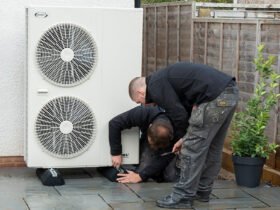Wall-mounted ladders efficiently access different levels, from floors to roofs. When installed correctly, they offer a safe and convenient means to perform maintenance, inspections, or simply move between floors. But improper setup can cause serious injuries and structural damage, making proper installation essential.
In this article, we’ll explore the most effective ways for installing wall mounted ladders to enhance safety and usability for floor and roof access.
Planning and Preparation
Before starting the wall mounted ladder installation, thorough planning and preparation are important. Here are some important points to remember:
1. Assess the Location
Wall Strength: Ensure the wall is strong enough to support the ladder and any potential weight. This involves checking the wall’s material and integrity, as weak walls can lead to dangerous failures. Reinforcement might be necessary if the wall is not initially up to standard. Consulting with a structural engineer can clarify whether your wall can handle the ladder installation. Proper assessment prevents future accidents and ensures the longevity of the installation.
Space: Make sure there is enough space around the ladder for safe use. Crowded or tight areas can increase the risk of accidents, as users might struggle to climb up or down. Ample space allows for easy maneuvering and reduces the chance of hitting obstacles. Measure the area accurately to avoid any miscalculations. Consider potential future changes in space that might affect ladder use.
Obstructions: Look for anything that could get in the way of using or installing the ladder. This includes pipes, wires, or other fixtures in the wall or ceiling. Finding these obstacles early lets you adjust where to put the ladder or make changes if needed. Moving or rerouting obstructions helps prevent hazards while using the ladder.
2. Choose the Right Ladder
- Material: Select a ladder made from durable materials like aluminum or steel. They offer strength and resistance to various weather conditions, ensuring longevity. For example, steel might be better for heavier loads, while aluminum is easier to handle. Quality materials also provide better safety for the users.
- Size: Ensure the ladder is the right length for the height you need to reach. If it’s too short, you won’t get to the right height, and if it’s too long, it can be hard to handle. The correct size will be stable and easy to use, so always measure accurately. Having the right length makes the ladder safe and easy to use.
- Load Capacity: Accurate measurements are key for safety. Check the ladder’s maximum weight limit, including the user and any tools or equipment. Overloading a ladder can cause accidents, so choose one that can hold more than the heaviest load you expect. Always consider the heaviest scenario to ensure safety. Regularly check the load capacity, especially if how you use the ladder changes. This helps prevent accidents and ensures the product remains safe to use.
3. Gather Tools and Materials
- Basic Tools: You’ll need a drill, screws, and anchors. Remember to wear safety goggles, gloves, and a hard hat to protect yourself during installation. Using personal protective equipment is key to staying safe from flying debris, sharp edges, or falls. Safety should always come first, so make sure your gear fits well and is used correctly. Never skip safety gear—it can make the difference between a minor incident and a serious injury. Also, keep a first-aid kit nearby.
- Ladder Components: Ensure all ladder parts are present and in good condition. Missing or damaged components can compromise the ladder’s stability and safety. Double-check the instructions to confirm that all necessary parts are included. Contact the manufacturer before installation if any parts are missing or defective.
4. Conduct a Thorough Site Assessment
Before installation, evaluate the location to ensure the ladder will fit properly and provide safe access. Consider potential obstacles, structural integrity of the mounting surface, and the specific needs of users. This assessment helps in identifying the most suitable type of ladder and ensures that installation won’t compromise safety or functionality.
5. Plan for Proper Clearance
Ensure there is ample space around the ladder for safe and unobstructed access. This includes adequate overhead clearance and sufficient room for mounting brackets. Measure the area carefully and account for the full range of movement required for safe climbing and descending. Lack of proper clearance can result in hazardous situations and discomfort during use.
Read Also:- Green Building
To Sum Up
A properly installed and maintained ladder provides convenient access and significantly enhances its users’ safety. Taking the time and effort to follow best practices during installation and maintenance is a wall valuable investment. This diligence helps prevent accidents and ensures everyone a secure and reliable climbing experience. By prioritizing safety and adhering to the mentioned guidelines, the ladder becomes a dependable tool.















Leave a Reply